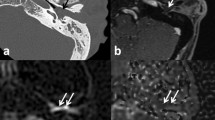Abstract
Background and purpose
The aim of the present prospective study was to verify the specificity of non-EPI DWI-MRI in patients operated for middle ear CHO who showed positivity at imaging performed 6 to 9 months after surgery and underwent second-look surgery.
Materials and methods
All patients underwent 1.5-T non-EPI DWI-MRI 6 to 9 months after surgery: those showing a hyper-intense signal in the middle ear underwent a revision surgery, whilst the others are still under radiological follow-up and were not considered in this study. Two radiologists independently evaluated the images; both placed a standard region of interest inside the brightest part of the observed signal alteration on coronal HASTE-DWI images. The mean and maximum signal intensity values on the DWI images were recorded for each patient. A signal intensity ratio was calculated using the inferior temporal cortex and the background noise.
Results
One hundred and forty-three subjects were evaluated for a total of 210 ears. In 116 (170 ears), a normal non-EPI DWI-MRI was found with exclusion from this study, whilst twenty-seven subjects showed a high signal lesion inside the middle ear and underwent revision surgery. According to the ROC analysis, SI, SIRT and SIRTmax showed the best statistical values in comparison with the other parameters.
Conclusions
Residual/recurrent CHO can be accurately detected using quantitative evaluation of non-EPI DWI-MRI.


Similar content being viewed by others
References
Henninger B, Kremser C (2017) Diffusion weighted imaging for the detection and evaluation of cholesteatoma. World J Radiol 28:217–222
Steens S, Venderink W, Kunst D, Meijer A, Mylanus E (2016) Repeated postoperative follow-up diffusion-weighted magnetic resonance imaging to detect residual or recurrent cholesteatoma. Otol Neurotol 37:356–361
Lingam RK, Nash R, Majithia A, Kalan A, Singh A (2016) Non-echoplanar diffusion weighted imaging in the detection of post-operative middle ear cholesteatoma: navigating beyond the pitfalls to find the pearl. Insights Imaging 7:669–678
Khemani S, Singh A, Lingam RK, Kalan A (2011) Imaging of postoperative middle ear cholesteatoma. Clin Radiol 66:760–767
Lingam RK, Khatri P, Hughes J, Singh A (2013) Apparent diffusion coefficients for detection of postoperative middle ear cholesteatoma on non-echo-planar diffusion-weighted images. Radiology 269:504–510
Suzuki H, Sone M, Yoshida T, Otake H, Kato K, Teranishi M et al (2014) Numerical assessment of cholesteatoma by signal intensity on non-EP-DWI and ADC maps. Otol Neurotol 35:1007–1010
Mateos-Fernandez M, Mas-Estellés F, de Paula-Vernetta C, Guzmán-Calvete A, Villanueva-Martí R, Morera-Pérez C (2012) The role of diffusion weighted magnetic resonance imaging in cholesteatoma diagnosis and follow-up. Study with the diffusion PROPELLER technique. Acta Otorrinolaringol Esp 63:436–442
von Kalle T, Amrhein P, Koitschev A (2015) Non-echoplanar diffusion-weighted MRI in children and adolescents with cholesteatoma: reliability and pitfalls in comparison to middle ear surgery. Pediatr Radiol 45:1031–1038
Garrido L, Cenjor C, Montoya J, Alonso A, Granell J, Gutierrez-Fonseca R (2015) Diagnostic capacity of non-echo planar diffusion-weighted MRI in the detection of primary and recurrent cholesteatoma. Acta Otorrinolaringol Esp 66:199–204
Nash R, Wong PY, Kalan A, Lingam RK, Singh A (2015) Comparing diffusion weighted MRI in the detection of post-operative middle ear cholesteatoma in children and adults. Int J Pediatr Otorhinolaryngol 79:2281–2285
Bakaj T, Zbrozkova LB, Salzman R, Tedla M, Starek I (2016) Recidivous cholesteatoma: DWI MR after canal wall up and canal wall down mastoidectomy. Bratisl Lek Listy 117:515–520
van Egmond SL, Stegeman I, Grolman W, Aarts MC (2016) A systematic review of non-echo planar diffusion-weighted magnetic resonance imaging for detection of primary and postoperative cholesteatoma. Otolaryngol Head Neck Surg 154:233–240
Osman NM, Rahman AA, Ali MT (2017) The accuracy and sensitivity of diffusion-weighted magnetic resonance imaging with apparent diffusion coefficients in diagnosis of recurrent cholesteatoma. Eur J Radiol Open 23:27–39
Lingam RK, Bassett P (2017) A meta-analysis on the diagnostic performance of non-echoplanar diffusion-weighted imaging in detecting middle ear cholesteatoma: 10 years on. Otol Neurotol 38:521–528
Khemani S, Lingam RK, Kalan A, Singh A (2011) The value of non-echo planar HASTE diffusion-weighted MR imaging in the detection, localisation and prediction of extent of postoperative cholesteatoma. Clin Otolaryngol 36:306–312
Maheshwari S, Mukherji SK (2002) Diffusion-weighted imaging for differentiating recurrent cholesteatoma from granulation tissue after mastoidectomy: case report. AJNR Am J Neuroradiol 23:847–849
Dremmen MH, Hofman PA, Hof JR, Stokroos RJ, Postma AA (2012) The diagnostic accuracy of non-echo-planar diffusion-weighted imaging in the detection of residual and/or recurrent cholesteatoma of the temporal bone. AJNR Am J Neuroradiol 33:439–444
Özgen B, Bulut E, Dolgun A, Ba** MD, Sennaroğlu L (2017) Accuracy of turbo spin-echo diffusion-weighted imaging signal intensity measurements for the diagnosis of cholesteatoma. Diagn Interv Radiol 23:300–306
Author information
Authors and Affiliations
Corresponding author
Ethics declarations
Conflict of interest
The authors declare that they have no conflict of interest.
Ethical approval
All procedures performed in studies involving human participants were in accordance with the ethical standards of the institutional and/or national research committee and with the 1964 Declaration of Helsinki and its later amendments or comparable ethical standards.
Informed consent
Informed consent was obtained from all individual participants included in the study.
Additional information
Publisher's Note
Springer Nature remains neutral with regard to jurisdictional claims in published maps and institutional affiliations.
Rights and permissions
About this article
Cite this article
Romano, A., Covelli, E., Confaloni, V. et al. Role of non-echo-planar diffusion-weighted images in the identification of recurrent cholesteatoma of the temporal bone. Radiol med 125, 75–79 (2020). https://doi.org/10.1007/s11547-019-01085-x
Received:
Accepted:
Published:
Issue Date:
DOI: https://doi.org/10.1007/s11547-019-01085-x




